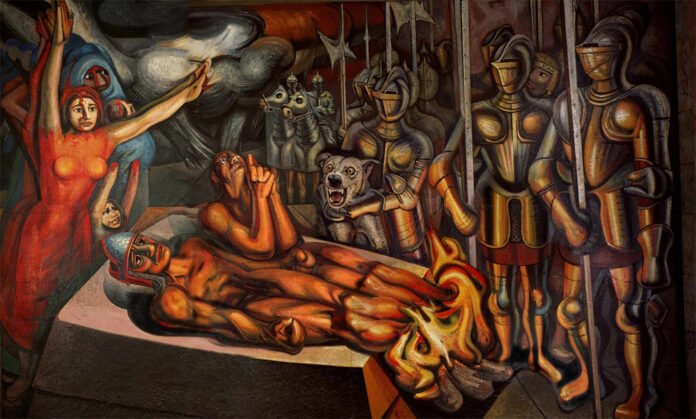The Federal and CDMX governments will pay tribute to the tlatoani Cuauhtémoc in the Zócalo. It is 500 years since he was disappeared by Hernán Cortés
by México Desconocido
This year marks 500 years since the death of the huey tlatoani Cuauhtémoc, murdered by Hernán Cortés, according to some sources, on February 28, 1525 (another date could be the 25th). Therefore, as an unprecedented event in history, President Claudia Sheinbaum announced a tribute to Cuauhtémoc in the Zócalo. It is expected that a recreation of the fight between the Spanish and the Mexicas will be held. In addition to this tribute, the Senate of the Republic recently also remembered the value of the last huey tlatoani of Mexico-Tenochtitlan.
For the first commemorative event of Cuauhtémoc’s death in the Zócalo, also the former political headquarters of Mexico-Tenochtitlán, screens, chairs and bleachers have been set up. Likewise, rehearsals have been held with dozens of people, so it is expected to be an event with a large number of artists on stage.
Commemoration of Cuauhtémoc in the Zócalo, how did he die?
Cuauhtémoc, or rather Cuauhtemoctzin (the honorific form of the tlatoani’s name in Nahuatl), was captured by Cortés and his allies on August 13, 1521. As a result, the heroic lord of Mexico-Tenochtitlan finally surrendered the city after a three-month siege. Later, the Tenochca ruler, along with the tlatoani of Tlacopan, were tortured to make them confess where Moctezuma Xocoyotzin’s treasure had been left, after the battle of the Noche Triste in 1520. When his feet were bathed in oil and burned by fire, Cuauhtémoc was left crippled, as recorded by the Spanish doctor Cristóbal de Ojeda.
Despite what happened, the young tlatoani was treated with a certain respect. And Hernán Cortés needed his authority to impose order among the Mexicas and to dialogue with the peoples formerly subject to Tenochtitlan. Despite being a ruler held captive by European power, Cuauhtémoc constantly interceded on behalf of his people in the years following the conquest of the Tenochca capital. As if that were not enough, he refused to be baptized. All of this generated various insecurities in the Extremaduran conqueror, who began to fear a rebellion led by the former lord of Tlatelolco.
The expedition to Las Hibueras and the death of the last Mexica tlatoani
In 1524, Hernán Cortés organized a military expedition against Cristóbal de Olid, who had betrayed him. The destination was the Hibueras region, which is currently Honduras. To do so, he mobilized at the head of a huge army where, as usual, the majority of the troops were the subjugated Mesoamerican peoples. The fact is that on that occasion, the bulk of the contingent was Mexica and to a lesser extent Tlaxcalan. For this reason, their main captains went, including the huey tlatoani Cuauhtémoc himself. In addition, with this Cortés managed to distance the noble Tenochca from his city, in order to avoid any uprising on his part.
A year after beginning the military campaign, Cortés received a certain Mexicalcingo, who told him of a supposed plot that the lord of Tenochtitlan was preparing to rise up against the conquistadors. Faced with this, the Castilian captain decided to execute Cuauhtémoc. The decision was controversial and questioned even by the Spaniards on the expedition. In the end, the young tlatoani was hanged along with the ruler of Tlacopan, Tetlepanquetzal, from the branch of a ceiba tree. Before that, he was baptized and given the Christian name Hernando de Alvarado Cuauhtemotzin. The gruesome death is estimated to have occurred around February 28, 1525 in Itzamkanac, currently the region of El Tigre, in Campeche, north of the border with Guatemala.
The last speech of the Huey Tlatoani
The last Mexica ruler was executed without trial by the Spanish invaders, and thus became a symbol of all the martyrs who saw the fall of the Mexica culture. Witnessing the end of their culture, the great orator offered these words:
«Our sacred energy has already seen fit to hide itself, our venerable sun has already worthily disappeared its face, and in total darkness it has deigned to leave us. We certainly know (that) it will deign to return again, that it will once again see fit to rise and will once again come worthily to enlighten us.»



